|
Printables |
PowerPoints |
Online exercises |
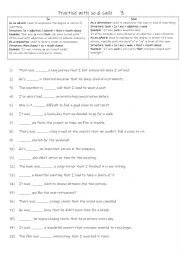
|
A2+-B1 Practise with so & such 3
First, students need to familiarise themselves with the 2 words. Then they read the sentences to work out which one is needed to complete the gap-fill. Each word is used 10 times! Answers on page 2
Level: elementary
Age: 9-100
Type:
Downloads: 110
|
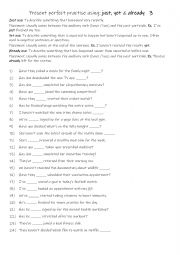
|
A2-B1 Present perfect practise using just, yet & already 3
First, students need to familiarise themselves with the 3 words and their use. Then they read the sentences to work out which one is needed to complete the gap-fill. Each word is used 8 times! Answers on page 2.
Level: elementary
Age: 9-100
Type:
Downloads: 110
|
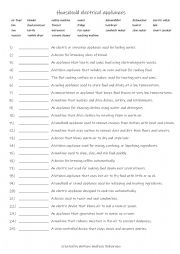
|
A1+-A2 25 Household electrical appliances
First, students need to familiarise themselves with the 25 words and their meanings Then they read the definitions to see which one is being described and write that word in the space provided. Answers on page 2.
Level: elementary
Age: 8-100
Type:
Downloads: 110
|
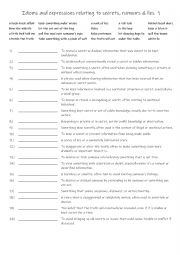
|
B1+-C1 Idioms and expressions relating to secrets, rumours & lies 1
First, students need to familiarise themselves with the 20 idioms and expressions and their meanings. Then they read the definitions to see which one is being described and write that word in the space provided Answers on page 2.
Level: intermediate
Age: 12-100
Type:
Downloads: 110
|
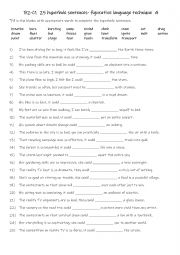
|
B2-C1 25 hyperbole sentences- figurative language technique 4
Recognising and using hyperbole sharpens analytical thinking, as students learn to interpret exaggerated expressions in context. Overall, mastering this figurative language technique makes both written and spoken communication more compelling and expressive. First, students need to familiarise themselves with the 25 words and their meaning. Then th...
Level: advanced
Age: 14-100
Type:
Downloads: 110
|
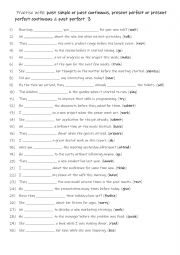
|
A2+-B1 Practise with past simple or past continuous, present perfect or present perfect continuous & past perfect 3
Students should practise past simple, past continuous, present perfect, present perfect continuous, and past perfect to communicate more precisely about different timeframes, actions, and experiences. These tenses help in narrating events, linking the past with the present, and describing ongoing actions. They improve fluency, enable clearer conver...
Level: elementary
Age: 10-100
Type:
Downloads: 110
|
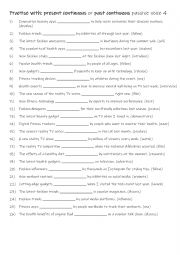
|
Practise with present continuous or past continuous passive voice 4
Learning the present and past continuous passive can be useful in formal writing, news reports, and academic contexts, where the focus is on the action rather than the doer. It helps describe ongoing processes and is commonly used in topics like construction, investigations, and legal matters (e.g., A new law was being discussed in Parliament). Ans...
Level: elementary
Age: 11-100
Type:
Downloads: 110
|
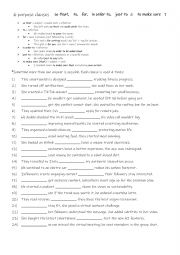
|
6 clauses of purpose 1
First, students need to familiarise themselves with the 6 clauses of purpose and their formation. Then they read the sentences to see which one is suitable to complete the gap-fill. Each type is used 4 times! Answers on page 2.
Level: elementary
Age: 9-100
Type:
Downloads: 110
|
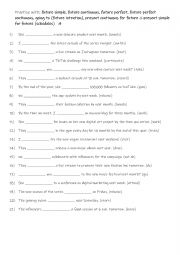
|
B1-B2 Future Simple, Future Continuous, Future Perfect, Future Perfect Continuous, Going to (Future Intention), Present Continuous for Future, Present Simple for Future (Schedules) � 4
First, students need to familiarise themselves with the tenses and check their meaning and use. Then they read the sentences to see which tense is needed to complete the sentence using the given verb in (). Each tense is used 3 times! Answers on page 2.
Level: intermediate
Age: 10-100
Type:
Downloads: 110
|
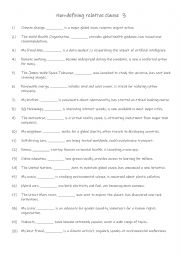
|
Non-defining relative clause 3
Students complete the gap-fill with the correct word. Answers on page 2.
Level: elementary
Age: 8-100
Type:
Downloads: 110
|
|
|
|
|












